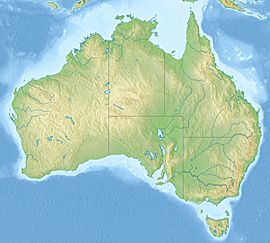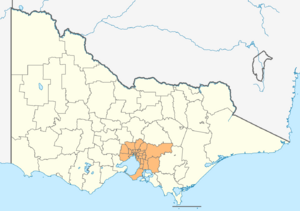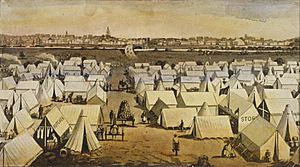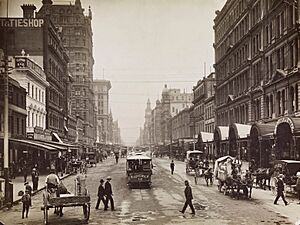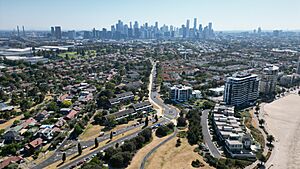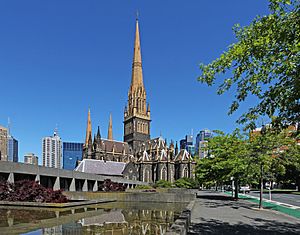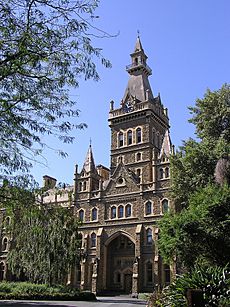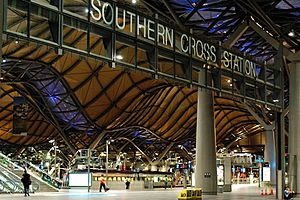Melbourne facts for kids
Quick facts for kids MelbourneVictoria |
|||||||||||||||
|---|---|---|---|---|---|---|---|---|---|---|---|---|---|---|---|
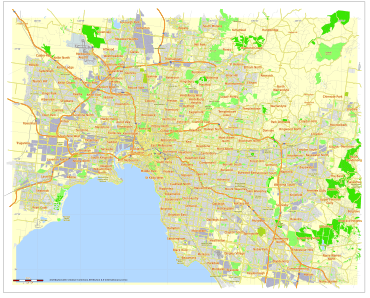
Melbourne metropolitan area
|
|||||||||||||||
| Population | 5,350,705 (2024) (2nd) | ||||||||||||||
| • Density | 6,656.8/km2 (17,241/sq mi) | ||||||||||||||
| Established | 30 August 1835 | ||||||||||||||
| Elevation | 31 m (102 ft) | ||||||||||||||
| Area | 803.8 km2 (310.3 sq mi)(GCCSA) | ||||||||||||||
| Time zone | AEST (UTC+10) | ||||||||||||||
| • Summer (DST) | AEDT (UTC+11) | ||||||||||||||
| Location | |||||||||||||||
| LGA(s) | 31 municipalities across Greater Melbourne | ||||||||||||||
| County | Bourke, Evelyn, Grant, Mornington | ||||||||||||||
| State electorate(s) | 55 electoral districts and regions | ||||||||||||||
| Federal Division(s) | 23 divisions | ||||||||||||||
|
|||||||||||||||
|
|||||||||||||||
Melbourne (pronounced MEL-bərn) is the capital city of Victoria, an Australian state. It is the second-largest city in Australia, right after Sydney. The name "Melbourne" usually refers to a large area called Greater Melbourne, which includes 31 local government areas. Sometimes, it refers specifically to the City of Melbourne, which is the central part of the city.
Melbourne is located around Port Phillip Bay and stretches into nearby areas like the Mornington Peninsula and the Yarra Valley. In 2023, about 5.2 million people lived in Melbourne. People who live in Melbourne are called "Melburnians."
For over 40,000 years, the Melbourne area has been home to Aboriginal Victorians. It was an important meeting place for the Kulin nation clans. The Boonwurrung, Woiwurrung and Wurundjeri peoples are the traditional owners of this land. Melbourne was founded in 1835 by settlers from Tasmania. It was named after William Lamb, 2nd Viscount Melbourne, who was the Prime Minister of the United Kingdom at the time. In 1847, Queen Victoria declared it a city. When Victoria became a separate colony in 1851, Melbourne became its capital.
During the Victorian gold rush in the 1850s, Melbourne grew very quickly and became one of the world's largest and richest cities. After Australia became a federation in 1901, Melbourne was the temporary capital until Canberra was built in 1927.
Today, Melbourne is a very diverse city with people from all over the world. It is a major financial hub in the Asia-Pacific region. The city has a mix of old Victorian buildings, like the Royal Exhibition Building, and modern skyscrapers. Other famous landmarks include the Melbourne Cricket Ground and the National Gallery of Victoria. Melbourne is known for its culture, including Australian rules football, Australian impressionism, and Australian cinema. It also has a lively street art and music scene. Major events like the Australian Grand Prix and the Australian Open are held here. Melbourne also hosted the 1956 Summer Olympics. For many years in the 2010s, Melbourne was ranked as one of the world's most livable cities.
Melbourne Airport is Australia's second-busiest airport. The Port of Melbourne is the busiest seaport in the country. Flinders Street railway station is the main train station for local travel. Southern Cross railway station is for regional and interstate trains. Melbourne also has a large network of freeways and the world's largest urban tram network.
Contents
Melbourne's Past: A Journey Through Time
Early Aboriginal Life in Melbourne
Aboriginal Australians have lived in the Melbourne area for at least 40,000 years. When British settlers arrived in the 1800s, about 20,000 Kulin people lived here. These included the Wurundjeri, Bunurong and Wathaurong groups. The area was a key meeting place and a source of food and water for the Kulin nation. The name Narrm is often used by Aboriginal people to refer to the city. It comes from the traditional name for the area where central Melbourne is built.
British Settlement and Growth
The first British settlement in Victoria was in 1803, but it moved to Tasmania a year later. In 1835, John Batman explored the Melbourne area. He claimed to have bought a large piece of land from eight Wurundjeri elders. However, this "treaty" is debated because they didn't speak the same language. The elders likely saw it as a temporary sharing of land.
Another group of settlers arrived in August 1835 and started a settlement. Batman and his group joined them later. The settlement was first called Dootigala. In 1836, Richard Bourke, the Governor of New South Wales, declared the city the capital of the Port Phillip District. He ordered the first city plan, the Hoddle Grid, in 1837. The settlement was named Melbourne on April 10, 1837, after the British Prime Minister, William Lamb, 2nd Viscount Melbourne.
Between 1836 and 1842, Aboriginal groups lost much of their land to British settlers. In 1840, Aboriginal people were banned from living near Melbourne. By 1844, many lived in poor camps around the city. On June 25, 1847, Queen Victoria officially declared Melbourne a city. On July 1, 1851, the Port Phillip District became the Colony of Victoria, with Melbourne as its capital.
The Gold Rush Era
The discovery of gold in Victoria in mid-1851 caused a huge Victorian gold rush. Melbourne, being the main port, grew incredibly fast. In just a few months, the city's population almost doubled from 25,000 to 40,000. By 1865, Melbourne had more people than Sydney.
Many people from Europe and China moved to Melbourne. This led to the creation of areas like Chinatown and temporary "tent cities." After the Eureka Rebellion in 1854, there was strong public support for miners. This led to important political changes and better working conditions.
The wealth from the gold rush led to many grand public buildings being constructed. These included Parliament House, the State Library, and the University of Melbourne. The city's layout, with wide streets and parklands, was also set during this time. Melbourne quickly became a major financial centre.
In 1859, members of the Melbourne Football Club created the rules for Australian rules football. In 1861, the first Melbourne Cup horse race was held. By the 1860s, the gold rush slowed, but Melbourne continued to grow. It became a major port for exporting farm products like wool.
Melbourne's Boom and Bust
The 1880s saw amazing growth in Melbourne. People were confident, credit was easy to get, and land prices soared. This "land boom" made Melbourne one of the richest cities in the world. It was the second-largest city in the British Empire, after London.
The Royal Exhibition Building was built for the Melbourne International Exhibition in 1880. Electric lights were installed in the Eastern Market in 1881. The Melbourne cable tramway system opened in 1885 and became one of the world's largest.
In 1885, a journalist called Melbourne "Marvellous Melbourne." This name stuck, describing the city's wealth and energy in the 1880s. Many large commercial buildings, hotels, and mansions were built. The city also expanded its railway network.
However, the land boom ended in the early 1890s. The financial and property markets crashed, leading to a severe economic depression. Many banks and companies failed. This crisis deeply affected Melbourne, and little new construction happened until the late 1890s.
Melbourne as Australia's Capital and Beyond
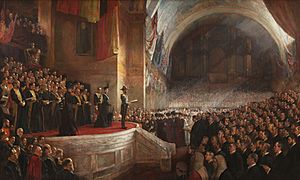
When Australia became a federation on January 1, 1901, Melbourne became the temporary capital. The first federal parliament met in the Royal Exhibition Building. It later moved to the Victorian Parliament House until Canberra became the permanent capital in 1927. During World War II, American military forces were based in Melbourne. The Melbourne Cricket Ground was even used by the military.
After World War II, Melbourne grew quickly due to many people moving to Australia, especially from Southern Europe. In 1958, rules limiting building heights were removed. This led to skyscrapers changing the city's skyline. Suburbs also expanded, with new shopping centres like Chadstone Shopping Centre. Many older buildings were either torn down or had their fronts kept while new buildings were built behind them.
The government also built public housing towers in the inner city. As more people owned cars, freeways were built, leading to more suburban growth. Melbourne remained Australia's main business centre until the late 1970s, when Sydney started to take over.
Melbourne faced an economic downturn from 1989 to 1992. In 1992, the government started a plan to boost the economy. They built new public works and promoted Melbourne as a tourist spot, focusing on major events and sports. The Australian Grand Prix moved to Melbourne. New projects included the Melbourne Museum, Federation Square, Crown Casino, and the CityLink tollway.
Modern Melbourne: Growth and Change
Since the mid-1990s, Melbourne has continued to grow in population and jobs. There has been a lot of international investment in the city. Areas like Southbank, Port Melbourne, and Melbourne Docklands have been redeveloped. From 2001 to 2004, Melbourne had the highest population and economic growth of any Australian capital city.
From 2006, the city's growth spread further out. The state government reviewed growth plans as the population was expected to reach 5 million. Melbourne was less affected by the Great Recession than other Australian cities. More new jobs were created in Melbourne than in Brisbane and Perth combined. Property prices also remained high.
Since the 2010s, the Victorian Government has started major projects to reduce traffic and boost the economy. These include the Metro Tunnel, the West Gate Tunnel, and the Level Crossing Removal Project. New development zones were created in inner-city areas. A construction boom saw 34 new skyscrapers built in the city centre between 2010 and 2020. In 2020, Melbourne was named an Alpha city, meaning it's a very important global city.
Melbourne was heavily affected by the COVID-19 pandemic, experiencing long lockdowns. This caused a temporary drop in population. However, Melbourne's population is expected to reach 6.4 million people by 2033-34.
Melbourne's Landscape and Climate
City Layout and Natural Surroundings

Melbourne's urban area is about 2,704 square kilometres, making it the largest in Australia. The city centre is built on the Hoddle Grid, a street plan about 1 by 0.5 miles. This grid is the heart of Melbourne's CBD. Newer developments in Southbank and Docklands have expanded the CBD. The CBD is known for its many small lanes and arcades, like Block Arcade.
Melbourne's CBD is Australia's most densely populated area, with about 19,500 residents per square kilometre. It has more skyscrapers than any other Australian city. Australia 108 in Southbank is one of the tallest buildings in the Southern Hemisphere. Many historic buildings like the Royal Exhibition Building are also in the CBD.
Melbourne is often called Australia's "garden city." There are many beautiful parks and gardens throughout the city, especially near the CBD. These parks have a variety of plants and walking paths. Several national parks are located around Melbourne, including the Mornington Peninsula National Park. The city is divided into hundreds of suburbs, managed by 31 local government areas.
Melbourne's Weather: Four Seasons in One Day
Melbourne has an oceanic climate, meaning it has warm summers and cool winters. It's famous for its changeable weather, often called "four seasons in one day." This is because it's located between hot inland areas and the cool southern ocean. This difference in temperature can cause strong cold fronts, bringing gales, thunderstorms, hail, and sudden temperature drops.
Winters are generally dry but can be drizzly and overcast. The city gets about 48 clear days each year. The lowest temperature ever recorded in Melbourne was -2.8°C in 1869. The highest was 46.4°C on February 7, 2009. Snow is rare in the city centre, but it sometimes falls in the higher areas on the outskirts.
The sea temperature in Port Phillip Bay is usually warmer than the ocean in spring and autumn. This can cause "bay effect rain," where showers become stronger near the bay.
Melbourne's Culture and Arts

Melbourne is often called Australia's cultural capital. It's known for its music, theatre, and art scenes, as well as many cultural events and festivals. These include the Melbourne International Arts Festival and Moomba, Australia's largest free community festival. Melbourne was ranked as one of the world's most livable cities for many years, partly because of its cultural offerings.
State Library Victoria, founded in 1854, is one of the world's oldest free public libraries. It is also one of the most visited libraries globally. Many famous Australian writers have set their stories in Melbourne. The city has the widest range of bookstores and the largest publishing industry in Australia. Melbourne also hosts the Melbourne Writers Festival. In 2008, it became the second City of Literature recognized by UNESCO.
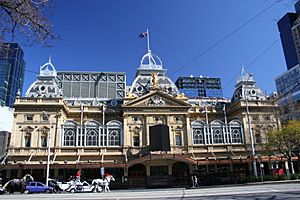
Melbourne has many theatres, with eight located in the East End Theatre District. These include historic theatres like the Princess Theatre. The Melbourne Arts Precinct in Southbank is home to Arts Centre Melbourne, the Melbourne Recital Centre, and the Malthouse Theatre. The Australian Ballet and Opera Australia are also based here. Many theatres host the annual Melbourne International Comedy Festival, one of the world's largest comedy festivals.
Melbourne is sometimes called "the live music capital of the world." It has more music venues per person than many other cities. Famous musicians like opera singer Nellie Melba and composer Percy Grainger came from Melbourne. The Sidney Myer Music Bowl hosted a huge concert by the band The Seekers in 1967, with an estimated 200,000 people attending. Melbourne has also been home to many influential bands and music styles, including Melbourne Bounce and the Melbourne Shuffle dance style.

The National Gallery of Victoria, established in 1861, is Australia's oldest and largest art museum. It has two locations: NGV International and NGV Australia. Several art movements started in Melbourne, including the Heidelberg School of impressionists. The city also has many independent galleries. Street art has become very popular in Melbourne, with "laneway galleries" like Hosier Lane attracting many tourists.
Melbourne has a rich history in filmmaking. The Story of the Kelly Gang (1906), filmed in Melbourne, is recognized as the world's first feature-length narrative film. Many films have been shot and set in Melbourne, including Mad Max (1979) and Animal Kingdom (2010). The Melbourne International Film Festival is one of the world's oldest film festivals. Docklands Studios Melbourne is a major film and TV studio complex.
Sports in Melbourne

Melbourne is known as Australia's sporting capital. This is because of its role in developing Australian sports, its many sporting events and venues, and the high number of people who watch and play sports. In 2016, Melbourne was named 'Sports City of the Decade' by the Ultimate Sports City Awards.
The city has hosted major international events, including the 1956 Summer Olympics and the 2006 Commonwealth Games. Melbourne also hosts annual events like the Australian Open, one of the four Grand Slam tennis tournaments. The Melbourne Cup horse race, first held in 1861, is a public holiday for Melburnians and is known as "the race that stops a nation." The Formula One Australian Grand Prix has been held at the Albert Park Circuit since 1996.
Cricket is very popular in Melbourne. The Melbourne Cricket Club manages the Melbourne Cricket Ground (MCG), one of the world's largest stadiums with a capacity of 100,000. The MCG hosted the first ever Test match and the first One Day International. It is also home to the National Sports Museum.
Australian rules football is Australia's most popular spectator sport. Its origins trace back to matches played near the MCG in 1858. The Melbourne Football Club helped create the first rules in 1859. The Australian Football League (AFL) is the top professional competition, with nine Melbourne-based clubs. The AFL Grand Final, held at the MCG, is the highest-attended club championship event in the world.
Melbourne also has professional teams in soccer (Melbourne Victory, Melbourne City FC, Western United FC) and rugby league (Melbourne Storm). Basketball, ice hockey, and baseball also have teams in Melbourne. Rowing is also a big part of Melbourne's sporting identity, with many clubs on the Yarra River.
Melbourne's Economy and Tourism
Economic Strengths
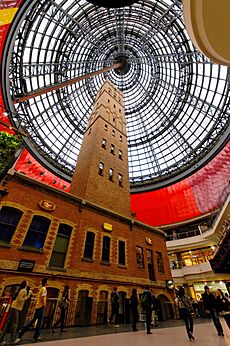
Melbourne has a very diverse economy. It is strong in finance, manufacturing, research, IT, education, and tourism. Many of Australia's largest companies have their headquarters in Melbourne, including ANZ, BHP, and National Australia Bank. The city is home to Australia's second busiest seaport and second busiest airport.
Melbourne is an important financial centre. Two of Australia's "Big Four" banks are based here. It is also a leading centre for superannuation (pension) funds. Melbourne is Australia's second-largest industrial centre. Many major manufacturers, from car companies to food processors, have bases here.
CSL, one of the world's top biotech companies, is headquartered in Melbourne. The city also has a strong ICT industry, employing over 91,000 people.
Exploring Melbourne: Top Tourist Spots
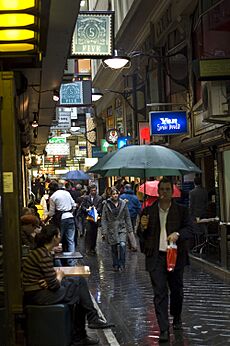
Melbourne is the second most visited city in Australia. In 2018, it welcomed 10.8 million Australian tourists and 2.9 million international visitors. Popular attractions include Federation Square, Queen Victoria Market, Crown Casino, Melbourne Zoo, Melbourne Aquarium, and the Melbourne Cricket Ground. The State Library of Victoria is one of the most visited libraries in the world. Luna Park, a fun theme park, is also a favourite. Melbourne's laneways and arcades are a special attraction, known for their street art and coffee culture.
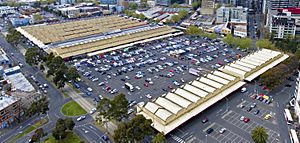
Melbourne has a famous food scene that attracts tourists. Lygon Street is a popular dining spot with many Italian and Greek restaurants. Food festivals are also very popular, especially in early autumn. The Melbourne Food and Wine Festival is a well-known event.
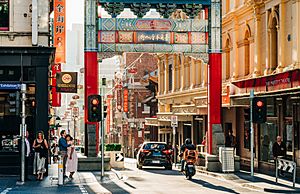
Melbourne hosts many annual events and festivals. The Melbourne International Comedy Festival is one of the three largest comedy festivals in the world. Other notable events include the Melbourne International Flower and Garden Show and the Melbourne Royal Show.
People and Diversity in Melbourne
Population and Ancestry
Melbourne is expected to become Australia's most populated city sometime between 2032 and 2046. After a period of lower population density, the city has seen more people moving into inner and western suburbs. This is partly due to government plans to reduce urban sprawl. As of 2018, the CBD is the most densely populated area in Australia.
At the 2021 census, the most common ancestries in Melbourne were English (24.8%), Australian (22.5%), and Chinese (8.8%). About 0.7% of Melbourne's population identified as Indigenous Australians. In 2021, 59.9% of Melbourne residents were born in Australia. The next most common birthplaces were India (4.9%), Mainland China (3.4%), and England (2.7%).
Languages Spoken at Home
In 2021, 61.1% of Melburnians spoke only English at home. Other common languages spoken were Mandarin (4.3%), Vietnamese (2.3%), Greek (2.1%), Punjabi (2%), and Arabic (1.8%).
Religious Beliefs
Melbourne has a wide range of religious faiths. Christianity is the most common, with two large cathedrals: St Patrick's (Catholic) and St Paul's (Anglican). Both are historic landmarks. In recent years, the number of people with no religion has grown significantly.
According to the 2021 Census, 36.9% of the population stated they had no religion. Christianity was followed by 40.1%. The largest Christian groups were Catholicism (20.8%) and Anglicanism (5.5%). Other popular religions included Islam (5.3%), Hinduism (4.1%), and Buddhism (3.9%).
Learning in Melbourne
Melbourne has many excellent schools. Five of Australia's top twenty high schools are in Melbourne. The city is also a popular place for international students. In 2024, Melbourne was ranked the 4th best city in the world for studying abroad.
Eight public universities operate in Melbourne: the University of Melbourne, Monash University, Swinburne University of Technology, Deakin University, RMIT University, La Trobe University, Australian Catholic University (ACU), and Victoria University (VU).
The University of Melbourne is the second oldest university in Australia and is highly ranked globally. Monash University is also ranked among the top 50 universities worldwide. Both are part of the Group of Eight, which are leading Australian universities. Education in Melbourne is managed by the Victorian Department of Education.
Getting Around Melbourne
Roads and Freeways

Like many Australian cities, Melbourne relies heavily on cars for transport, especially in the outer suburbs. There are 3.6 million private vehicles using 22,320 km of roads. The popularity of cars led to large suburban expansion. By 2013, there were 600 passenger vehicles for every 1000 people.
The road network in Victoria is managed by the Department of Transport and Planning. Local roads are maintained by local governments, while main roads are the state's responsibility. Major national freeways are overseen by the Federal Government.
Melbourne has a large network of freeways and main roads. These are used by private cars, trucks, buses, and taxis. Major highways include the Eastern Freeway, Monash Freeway, and West Gate Freeway. The Tullamarine Freeway is the main link to the airport. The Hume Freeway connects Melbourne to Canberra and Sydney. The M80 Ring Road connects the middle suburbs.
Six of Melbourne's freeways are electronic toll roads, including the M1 and M2 CityLink (which includes the large Bolte Bridge). Toll roads in Melbourne have blue and yellow signs.
Public Transport System
Melbourne has an integrated public transport system with trains, trams, and buses. Flinders Street railway station was once the world's busiest passenger station in 1927. Melbourne's tram network became the world's largest in the 1940s.
Public transport use declined after the 1940s as more roads were built. However, since 1996, more people have been using public transport, especially for commuting to central Melbourne. The state government aims to increase public transport use. Many projects have started to expand the network.
Train Travel in Melbourne
Melbourne's metropolitan train network started in the 1850s during the gold rush. Today, it has 222 suburban stations on sixteen lines that connect to the City Loop, an underground subway system around the CBD. Flinders Street railway station is a major hub and a famous Melbourne landmark.
Melbourne also has train connections to regional Victorian cities and direct interstate services from Southern Cross railway station. The Overland train goes to Adelaide twice a week, and the XPT goes to Sydney twice daily. In 2017–2018, the Melbourne train network had its highest number of passengers ever.
New railways are being built in Melbourne. The Metro Tunnel will open by 2025 to reduce congestion. The Level Crossing Removal Project is removing many railway crossings. Early work has also started on the Suburban Rail Loop, a 90-kilometre underground orbital line, and an airport rail connection to Tullamarine.
Melbourne's Trams: A World Record
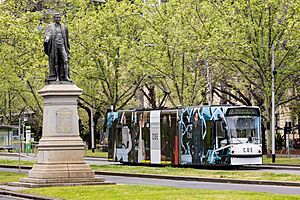
Melbourne's tram network started in the 1880s. As of 2021, it is the largest in the world, with 250 km of track, 475 trams, 25 routes, and 1,763 stops. In 2017–2018, trams carried over 206 million passengers. Melbourne's trams are seen as iconic cultural symbols and a tourist attraction. Historic trams operate on the free City Circle route around the CBD. Trams are free within the central city Free Tram Zone and run 24 hours on weekends.
Bus Services
Melbourne's bus network has over 400 routes. These mainly serve the outer suburbs and fill gaps where there are no train or tram services. In 2023–2024, Melbourne's buses recorded 114.9 million passenger trips.
Airports Serving Melbourne
Melbourne has four airports. Melbourne Airport at Tullamarine is the city's main international and domestic airport. It is Australia's second busiest airport. It is a major base for airlines like Jetstar, Qantas, and Virgin Australia. Avalon Airport, between Melbourne and Geelong, is a smaller hub for Jetstar. Buses and taxis are the main public transport options to and from the airports. A train link to Tullamarine Airport is planned to open in the 2030s.
Moorabbin Airport in the southeast handles general aviation and some passenger flights. Essendon Airport, once the city's main airport, also handles passenger and cargo flights.
Water Transport
Ship transport is important for Melbourne. The Port of Melbourne is Australia's largest and busiest container and cargo port. Station Pier on Port Phillip Bay is the main terminal for passenger cruise ships. Ferries and water taxis operate along the Yarra River and across Port Phillip Bay.
City Services and Infrastructure
Healthcare in Melbourne
Melbourne has a high life expectancy. The Victorian Government's Department of Health manages about 30 public hospitals in the Melbourne area.
Melbourne is home to many important medical, neuroscience, and biotechnology research institutions. These include the St. Vincent's Institute of Medical Research, the Burnet Institute, and the Walter and Eliza Hall Institute of Medical Research. Many of these institutions are located near universities. Melbourne also has major children's hospitals like the Royal Children's Hospital and the Monash Children's Hospital.
Utilities: Water, Gas, and Electricity
Water for Melbourne is managed by Melbourne Water, a Victorian Government-owned company. They also handle sewerage and manage major water catchments. Water is stored in reservoirs, with the largest being the Thomson River Dam in the Victorian Alps.
Gas is supplied by three companies: AusNet Services, Multinet Gas, and Australian Gas Networks. Electricity is provided by five distribution companies: Citipower, Powercor, Jemena, United Energy, and AusNet Services. Each company serves different parts of the city and surrounding areas.
More About Melbourne
- List of Melbourne suburbs
- List of museums in Melbourne
- List of people from Melbourne
See also
 In Spanish: Melbourne para niños
In Spanish: Melbourne para niños








